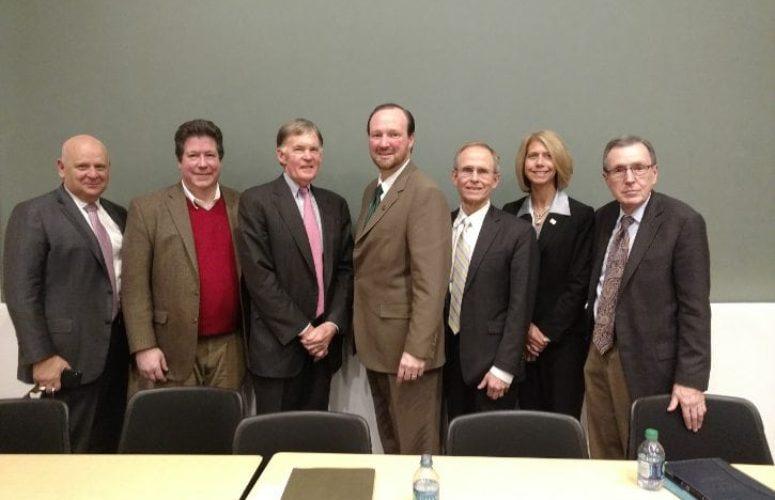
Big Changes and New Challenges 10 Years after the Great Recession
By Anthony Birritteri, Editor-in-Chief On Jan 12, 2018Last month marked the 10th anniversary of the Great Recession, and to note the occasion, economists and business leaders gathered recently to discuss how far the U.S. and New Jersey economies have come, in what is now the third longest economic expansion period in U.S. history. The good news is that these experts assert the expansion will continue into 2018, but they also say there are caveats in terms of workforce shortages and related skills gaps, the impact of the federal governments Tax Cuts and Jobs Act on New Jersey, and the state’s own dilemma relating to high property taxes.
At the event, held Wednesday at the Edward J. Bloustein School of Planning and Public Policy at Rutgers University, New Brunswick, Distinguished University Professor and Economist James W. Hughes said the economic expansion is just four months shy of being the second longest in U.S. history, adding that “this is a unique national upcycle that is providing New Jersey with economic tail winds, and there is no end in sight as 2018 unfolds.”
However, Hughes described the economy as a cyclical roller coaster and at, some point, there must be a setback.
He pointed to a number of long-term structural changes over the course of the 10-year recovery and expansion that he called fundamental disruptors that have changed the demographic and economic underpinnings of the state’s economy.
The first is the “greatest age structure transformation in history where millennials are now the prized labor force commodity eagerly sought by corporate America. Where that millennial talent wants to be is driving corporate location decisions,” Hughes said.
And that location is our urban centers, which leads to another structural change. “The fortunes of the state’s urban and suburban office markets have been reversed,” Hughes said. “As far back as 2007, the state’s economy was still overwhelmingly suburban-centric, largely staffed and controlled by baby boomers. However, during the decade that followed the Great Recession, suburban office fatigue overwhelmed New Jersey and the broader region. Corporate America adopted a new mantra: the belief that a culture of innovation and collaboration thrives in dense, interactive multi-functional urban environments desired by millennials. So, portions of our suburban inventory are now over supplied and under demolished.”
Another structural change is the new reality of workforce constraints. Hughes said that on a monthly basis, there are 6.2-million unfilled job openings across the country. This is a new all-time record high and far greater than previous record 4.5-million monthly job openings of the last business cycle peak. Job growth is being constrained because there is a mismatch between workers skills and job requirements, geographic location preferences and opioid and drug problems, Hughes said.
Finally, he pointed to a retail and distribution revolution. Historically, the Garden State’s core economic competency was baby-boom-driven, bricks-and-mortar-based consumption. “Now, changing spending habits and advancing information technology are revolutionizing how shopping takes place,” he said. “At its peak, New Jersey had one of the greatest concentrations of impenetrable shopping fortresses known as enclosed super regional malls. Now, this vast standing inventory faces challenges similar to suburban office spaces. And, this period of rightsizing regional malls has just begun,” he said.
At the same time, e-commerce is revolutionizing the state’s warehouse and logistics infrastructure with fulfillment centers proliferating throughout the state. Hughes said New Jersey is the nation’s third largest warehouse/distribution market with more than 900 million square feet of space.
Jeffrey G. Otteau, president of the Otteau Group, Inc., a multi-discipline real estate appraisal and advisory firm, said the nation has shifted to a European model in terms of our society, the economy and real estate demand.
More people will be living in apartments, in urban centers and/or closer to mass transportation, than in single family homes. Additionally, the size of the household is getting smaller. In New Jersey, for example, 60 percent of homes are only occupied by one to two people. Coupled with low birth rates the nation has been seeing over the last 10 years, Otteau said these trends all reflect a European model of living.
What may drive the increase in apartment living further, and, in turn, result in the decline of single family home ownership, is the increase in the standard deduction for joint income tax filers from $12,000 to $24,000 under the federal Tax Cuts and Jobs Act.
“Being permitted to take large deductions on your income taxes to reduce your federal income tax burden was previously the exclusive domain of home owners. If you were a renter household, you did not have access to that tax haven,” Otteau said. “That has all changed because regardless of whether you are a homeowner or a renter, if you are a married couple, your standard deduction has been raised to $24,000. So, more people may make the decision to rent or to move to another state where state and local taxes are much less.”
He did say, however, that the multi-family market is being overbuilt. “We went from having 5,000 apartments under construction in 2010 to 34,000 in the ground right now in the state, and this does not include projects which have been approved, but for which construction has not yet commenced. There is no question about it, we will overbuild the apartment market. There will be less demand heading into the future,” he said.
During a panel discussion on further economic trends in the state, Michele Siekerka, president and CEO of the New Jersey Business & Industry Association, said she was not shocked by what she heard from the economists.
“What members told us in NJBIA’s recent 53rd Annual Business Outlook Survey (published last December) is consistent with what we have heard today; the positive side being that companies continue to see profit growth going into 2018. However, partnered with that is a concern regarding the lack of certainty for new policy coming to the state. … Businesses are concerned that a very progressive agenda is coming to New Jersey,” Siekerka said.
Touching upon an NJBIA outmigration report, which revealed that $21 billion in net adjusted gross income left the state over the last 11 years, Siekerka explained that a large portion of that money belonged to senior citizens. Thanks to NJBIA helping to advocate for estate tax relief, which was received in 2016 as part of a comprehensive tax reform package, Siekerka said, “The needle has started to move, with those contemplating retirement not as quick to leave the state, based on our Business Outlook Survey. However, those same seniors who would like to hold onto their homes may not receive the benefit of federal tax relief under the Tax Cuts and Jobs Act because they would be hurt on the [revised] State and Local Tax (SALT) deductions. That is something we have to pay attention to.”
Tom Bracken, president and CEO of the New Jersey Chamber of Commerce, also agreed with Siekerka on the Tax Cuts and Jobs Act, saying that people with higher incomes will not benefit … “and these are the people for whom we got rid of the estate tax. [Because of the Act,] we are going to make their affordability issue and their desire to stay here less attractive. These people are the job creators and, the more they leave, the more problems we will have in the state,” he said.
Regarding millennials – the No. 1 outmigration group in the state – Siekerka commented, “We are not keeping that population here for college after we invest in k-12 education to the tune of $20,000 per pupil. Times that by 13 years and think about the lack of return on investment.”
Additionally, those millennials staying here cannot afford to live in the state. They have, on average, $30,000 in college debt and many are forced to live with their parents. In fact, New Jersey is the No. 1 state for millennials still living with their parents, Siekerka said.
On the skills gap that Hughes discussed earlier, Siekerka added, “We need to recognize that not every student is meant to go on to a four-year traditional college. Many of the unfilled jobs can be done with a credential or certificate. Young people can get those in an affordable manner and start building their career ladder.”
Discussing Hughes’ comments on the impact of e-commerce on the brick-and-mortar retail landscape, Michael J. Darcy, executive director of the New Jersey State League of Municipalities, blamed the Internet and, in turn, those responsible for its early growth (politicians, regulators and online businesses, etc.,) for allowing online commerce to be transacted tax free. “Early on, we saw the brick-and-mortar decline as an effect of the Internet, because the transactions that were occurring were still escaping the sales tax. The early argument was, ‘You have to give the Internet a chance to grow,’ but the technology was a disruptor. The answers are not clear in taking that disruption and using it to your advantage, rather than just closing shops and boarding up stores on Main Street.”
All three panelists said the 2 percent arbitration cap on property taxes, which expired this past December 31st and which in-coming Governor Phil Murphy has not said if he will renew or not, will have a negative impact on residents and businesses if it is not reinstated.
Property taxes are probably the No 1 decisive factor for people leaving or remaining in the state, therefore the 2 percent arbitration cap “is the telling issue for the state right now,” Bracken said.
“Without it, things will be terrible for municipal budgets,” Darcy added.
Siekerka and Bracken, co-chairs of Opportunity NJ, both discussed a whitepaper that the organization gave to Governor-elect Phil Murphy two days after the election this past November, focusing on four main business issues in the state: over taxation, over regulation, workforce development and infrastructure investment.
Siekerka said the business community was promised a seat at the table of the new administration and that “our information, thoughts and recommendations would be welcome.”
In terms of the new administration’s progressive agenda, Siekerka commented that “many times, we have more in common than we have apart. My mantra has been to focus on the gray areas we have in common and not allow external forces to polarize us. Then, we can work together on solutions and get things done.”
Related Articles:





